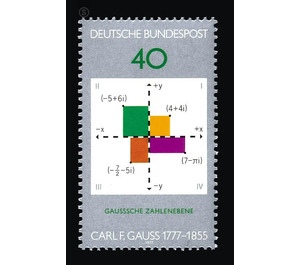200th birthday of Carl Friedrich Gauß - Germany / Federal Republic of Germany 1977 - 40 Pfennig
Theme: Calender
| Country | Germany / Federal Republic of Germany |
| Issue Date | 1977 |
| Face Value | 40.00 |
| Color | grey |
| Perforation | K 14 |
| Printing Type | 5-color offset |
| Stamp Type | Postage stamp |
| Item Type | Stamp |
| Chronological Issue Number | 817 |
| Chronological Chapter | GER-BRD |
| SID | 503331 |
| In 48 Wishlists | |
Two hundred years ago Carl Friedrich Gauss was born in Braunschweig, the later "mathematicorum princeps" - prince of mathematicians - as it was called on a commemorative coin in 1855, the year of his death. The modern higher algebra can not be separated from the preparatory work done by Carl Friedrich Gauss (1777-1855). Gauss already proved in his dissertation at the University of Helmstedt in 1799 that a mathematical equation of the nth degree has n solutions and showed that all solutions of algebraic equations are so-called complex numbers. These complex numbers have been introduced by Gauss in mathematics. In order to be able to illustrate complex numbers, Gauss used the coordinate system shown on the special stamp, the Gaussian number plane named after him in this context. Gauss wanted to use the complex numbers to decipher the secret of v-1. The mathematical expression v-1 requires finding a number that multiplied by itself gives the value -1. Such a number existed in the realm of the so-called real numbers known up to Gauss's work; these are the numbers familiar to us, such as the B. 1, 2, 3, - 1, - 4, 1/2, xn, nvx, etc. not. Gauss himself writes: "The true meaning of the v-1 stands before me with great liveliness in front of the soul, but it will be very difficult to put into words." For mathematically interested one should note that Gauss the solution by extension of the Number line to a number plane (the Gaussian plane) by forming a rectangular coordinate system from the known number line and a new number line, the so-called imaginary axis found. Each point in this number plane is determined by a pair of numbers and represents the mapping of a complex number, i. a complex number is the numerical value of a point in the Gaussian number plane. The complex numbers are subject to the same rules of calculation as the hitherto known real numbers. This fact allowed Gauss to give a (complex) number "i" that multiplied by itself gives the value -1, "i" is the so-called imaginary unit, which is a complex number in the Gaussian plane at distance i from 0. Point on the vertical axis, i is the solution of the expression v-1. The practical significance of this extension of number theory, in particular of the representation of complex numbers by the Gaussian numerical level, is manifold and opens up a dimension previously unknown to mathematics but existing. The complex numbers, considered as vectors, allow e.g. in the field of electrical engineering, the behavior of the alternating currents mathematically simple and clear to grasp, so to calculate sizes that, acting in the form of machines and apparatus, help us to cope with our daily lives.


